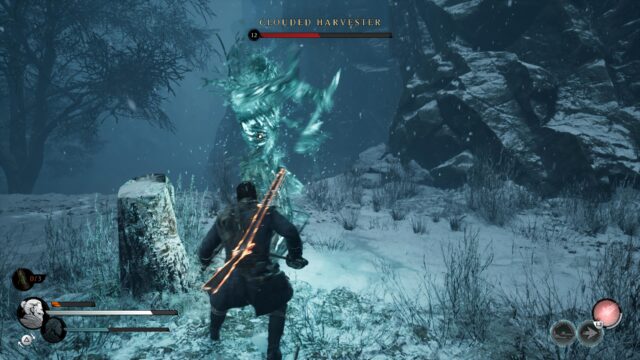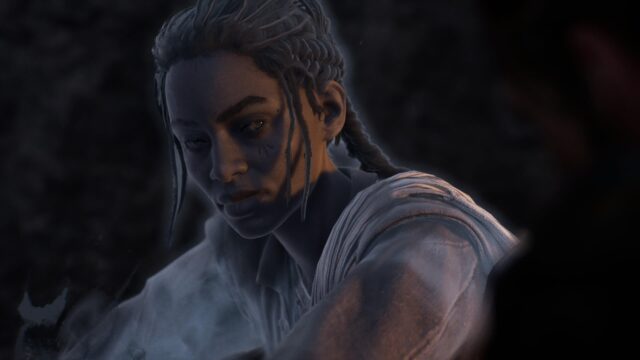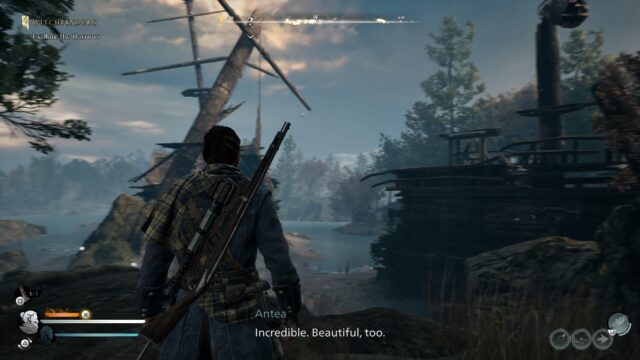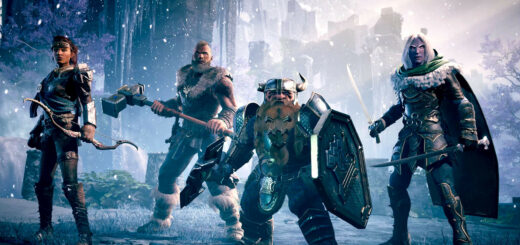Banishers: Ghosts of New Eden Review
To Live and Die in Fantasy New England
How do you say goodbye to someone for the last time? If given the option, do you hold off goodbye for just a little bit longer together, even if comes at a hefty price? In Banishers: Ghosts of New Eden, death permeates every corner of the world. Ghosts are real and have a perceivable impact on the world. They latch on to the living, driven by strong emotional impulses. At the heart of those impulses are people and the harm they can visit on one another. Here is a story deeply interested in big questions regarding death, human failings, relationships, and forgiveness and for some reason it takes a similar form to the action-heavy modern God of War games.
Couple Antea Duarte and Red mac Raith are the titular Banishers, traveling together and hunting ghosts, seeking to free spirits of their ties to the world of the living and remove any negative influence they have over individuals or locations. The pair’s work brings them to New Eden, a fictional New England town that has a severe haunting. Underestimating the scope of the threat, their initial contact with the ghost reveals it to be a Nightmare, a powerful and angry spirit who easily kills Antea and throws Red in a river. When Red recovers thanks to the help of a mysterious woman, he finds that a fully cognizant Antea has become a ghost and that the area surrounding New Eden has fallen under the Nightmare’s influence. Determined to undo the damage caused by the Nightmare, the two must cross the treacherous landscape back to New Eden, helping the remaining people along the way.
The first noticeable thing about the game is just how much it takes its time. Banishers is a surprisingly big game and one that has a deliberately slow pace. Even once out of the intro, which can take over an hour depending on how thorough a player is, the game rarely ever kicks it into high gear. This isn’t necessarily a bad thing, however. What the plot often lacks in urgency it makes up for in an understated atmosphere that helps to highlight the core relationship between the two characters. Central to what makes this game work are its two leads and how the game depicts their interactions. There are layers to their relationship that are seldom seen in games, such as in the ways that Antea is Red’s mentor and how their power dynamic shifts to even in the same scene to reflect that. Maybe most importantly, in spite of all the fantastical elements going on, their tragedy feels very human.
As Antea is now a ghost, it is Red’s duty to help her pass to the world beyond. But his love for her, and his guilt over her death, has him consider the possibility of a resurrection, which goes against their code but is an option on the table. Here the slower pace also helps. While the two march back toward New Eden, constant diversions and excursions present themselves that the game incentivizes players to take, both for the mechanical benefits but also to give Antea and Red just a little more time together. They’re in no rush to get there because what that will likely mean is having to say goodbye again. But the potential for resurrection is also the backbone of the game’s moral choice systems.

Enemies tend to either be ghosts or ghosts possessing dead bodies, giving them access to a second health bar.
The process for resurrection isn’t all that different mechanically from the Banishers’ regular job, it more seems positioned on how one metes out justice. Along their travels, Antea and Red will come across people who are haunted and the two take it upon themselves to help. These hauntings play out as mysteries to be solved, culminating in a standoff where Red will get to act as judge, jury, and executioner. Unfortunately, the mysteries themselves are mostly on rails. There isn’t much actual detecting or logical thinking to do, its largely go to a location, interact with everything there, run to another location, fight some people, and then make a choice regarding who is most responsible for the haunting. The player will have to choose to place blame on the living person being haunted or to send the ghost away. Banishment or ascension, will either send the ghost to the void or free their soul for the afterlife.
While the writing remains strong throughout these stories, they stumble when it comes to the choice at the end. In a play for moral ambiguity players are only allowed to choose one extreme outcome when many others would make more sense, such as reporting a person for a crime they committed without damning their soul. Part of this is also tied up in whether or not the player attempts to resurrect Antea or not, as living souls must be collected for the ritual, but this further complicates the moral choice here. It’s true that this option gives players the choice to act more selfishly, the act gets mechanically framed as a selfish one even if the most moral course of action is to blame the living person. The limited choice in resolving these mysteries reflects how strict the actual gameplay during these segments is.
The rest of the gameplay suffer in similar ways. Combat is, in a word, fine. The action bits are competent and even has thematic twist that is initially a pretty fun. But several main issues end up holding it back: First, the parry just isn’t very good. It takes longer than desired to get used to the timing and even then the feedback is lacking, both in audio and in the controller. The second is that its oddly prescriptive the further on it goes. The one cool idea present is that players can swap between Red and Antea at the press of the button. Red uses physical weapons and can banish enemies while Antea deals spirit damage and can utilize powerful Manifestations. Being already dead, Antea doesn’t take damage but instead has a meter that fills as Red attacks and drains as Antea attacks, takes damage, or uses Manifestations. It’s a thematically strong decision, as the the two need to work together and make full use of each other’s abilities to best overcome enemies. It also provides a neat defensive option, as swapping to Antea can eat some damage that would otherwise go to Red.
In practice, it tends to lock players into a very specific loop. Many of the game’s skills involve setting up a more powerful attack after using a different kind of attack. For example, increasing the damage of the next heavy attack after using a Manifestation. Instead of there being an interesting push and pull to the fights, players run through the same routine in every battle, breaking from it only to account for moves that needed to be avoided or to single out high priority targets. The last big issue is that there’s both way too much time spent in combat and far too few types of enemies to justify it. Not helping matters is the game’s exploration. The environments look great and are quite evocative but the artifice surrounding them is too obvious. Squeezing through nooks, shuffling along thin outcroppings, and climbing predetermined paths are all obstacles that are constant and unengaging and seem to exist for little more than to separate the combat rooms from one another. There’s just very little to discover while exploring, just combat encounters, the occasional puzzle, or various challenge rooms that are little more than combat encounters with special rules. The large maps also become tiresome to traverse and it happens quite frequently when trying to solve mysteries.
With that said, Banishers is a beautiful game. When presenting a new set piece or when reaching a climactic fight against one of the unique bosses, the game absolutely shines with creative visual designs. The voice acting is great throughout, especially Amaka Okafor and Russ Bain as Antea and Red, who convincingly sell a lived-in relationship in a way that video games rarely attempt. The score doesn’t stand out in a meaningful way, but outside of parrying the game’s sound design is on point. The only real technical issue on PS5 came from there being a second long pause every time the menu opened. Annoying, but manageable. As a quick note, the ending felt oddly rushed considering how deliberate the rest of the pacing was. However, this is a game with multiple endings so there’s the chance that the others flow better.
Banishers is not quite the unqualified win I wanted it to be, but it’s easy to appreciate on its merits. While the combat overstays its welcome and the exploration leaves a lot to be desired, there’s enough here to like for those who like strong narratives with great characters. For all its faults, the game is entirely confident in what it’s attempting to do. What’s more, with the foundation laid there’s plenty of potential for its faults to be addressed in future works. And it will be interesting to see what this team does next.
Disclosure: This review is based on a free copy of the game provided by the publisher.
A strong central relationship that anchors the story
The dialogue is pretty good throughout
The premise and setting show promise
The game's mysteries mostly play themselves
Combat is too prescriptive
RPG elements tend to emphasize this








Recent Comments